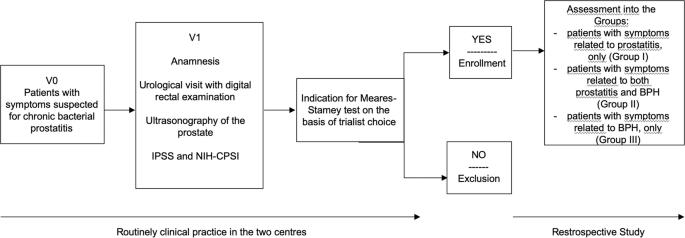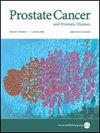The diagnostic yield of the Meares & Stamey test can be significantly improved by symptom-based patient selection and the experience of the test performer
IF 5.1
2区 医学
Q1 ONCOLOGY
引用次数: 0
Abstract
Even if Meares-Stamey 4-glass (M&S) test is regarded a decisive tool for diagnosing prostatitis its use is only rarely performed in everyday clinical practice. Here, we analyze if the diagnostic yield of the M&S test could be improved by a pre-test categorization of patients due to undergo a M&S test. All clinical and microbiological data of patients who underwent M&S test in two urological centers from January 2004 to December 2021 were analyzed in this retrospective cohort study. One center has a dedicated staff member for the study of prostatitis (Cohort I), while the other center is a general urological unit (Cohort II). All patients were divided into 3 groups on the basis of the assembled data: patients with symptoms related to prostatitis only (Group I), patients with symptoms related to both prostatitis and BPH (Group II), patients with symptoms related to BPH only (Group III). The rates of positive microbiological results in each group were compared. In the whole period, 9347 patients were analyzed and categorized as follows: Group I, 1884; Group II, 5151; Group III, 2312. Three-thousand and eight-hundred twenty-three patients showed positive culture results (40.9%). The most common isolated species was Escherichia coli (49.7%), followed by Enteroccus spp. (31.8%). The rates of positive M&S tests in the different symptom groups were: Group I, 1532 (81.4%); Group II, 1494 (29.0%); Group III, 797 (34.4%). The overall rate of positive M&S tests in each urology center showed that the center with a staff member who is dedicated to prostatitis studies (Cohort I) had a significantly higher rate of positive M&S tests than the general urological department (Cohort II) (64.3% vs 31.4%; p < 0.001). Symptom-based patient selection and dedicated staff members will increase the diagnostic yield of the M&S test and reduce the number of unnecessary tests.

通过根据症状选择病人和测试人员的经验,可以大大提高 Meares & Stamey 测试的诊断率。
背景:尽管Meares-Stamey 4-glass(M&S)检验被认为是诊断前列腺炎的决定性工具,但在日常临床实践中却很少使用。在此,我们分析了是否可以通过对即将接受 M&S 检验的患者进行检验前分类来提高 M&S 检验的诊断率:这项回顾性队列研究分析了 2004 年 1 月至 2021 年 12 月期间在两家泌尿外科中心接受 M&S 检验的患者的所有临床和微生物学数据。其中一个中心有专门研究前列腺炎的工作人员(队列 I),而另一个中心是普通泌尿科(队列 II)。根据收集到的数据,所有患者被分为三组:仅有前列腺炎相关症状的患者(第一组)、同时有前列腺炎和良性前列腺增生相关症状的患者(第二组)、仅有良性前列腺增生相关症状的患者(第三组)。比较了各组微生物结果的阳性率:结果:在整个研究期间,共对 9347 名患者进行了分析,并将其分类如下:第一组,1884 人;第二组,5151 人;第三组,2312 人。有 3 823 名患者的培养结果呈阳性(40.9%)。最常见的分离菌种是大肠杆菌(49.7%),其次是肠球菌属(31.8%)。不同症状组的 M&S 检测阳性率分别为第一组,1532 例(81.4%);第二组,1494 例(29.0%);第三组,797 例(34.4%)。从各泌尿外科中心的 M&S 阳性率来看,有专人负责前列腺炎研究的中心(第一组)的 M&S 阳性率明显高于普通泌尿外科(第二组)(64.3% vs 31.4%;P 结论:根据症状选择患者和专人负责前列腺炎研究的中心(第一组)的 M&S 阳性率明显高于普通泌尿外科(第二组)(64.3% vs 31.4%;P):根据症状选择患者和专职人员将提高 M&S 检验的诊断率,并减少不必要的检验次数。
本文章由计算机程序翻译,如有差异,请以英文原文为准。
求助全文
约1分钟内获得全文
求助全文
来源期刊

Prostate Cancer and Prostatic Diseases
医学-泌尿学与肾脏学
CiteScore
10.00
自引率
6.20%
发文量
142
审稿时长
6-12 weeks
期刊介绍:
Prostate Cancer and Prostatic Diseases covers all aspects of prostatic diseases, in particular prostate cancer, the subject of intensive basic and clinical research world-wide. The journal also reports on exciting new developments being made in diagnosis, surgery, radiotherapy, drug discovery and medical management.
Prostate Cancer and Prostatic Diseases is of interest to surgeons, oncologists and clinicians treating patients and to those involved in research into diseases of the prostate. The journal covers the three main areas - prostate cancer, male LUTS and prostatitis.
Prostate Cancer and Prostatic Diseases publishes original research articles, reviews, topical comment and critical appraisals of scientific meetings and the latest books. The journal also contains a calendar of forthcoming scientific meetings. The Editors and a distinguished Editorial Board ensure that submitted articles receive fast and efficient attention and are refereed to the highest possible scientific standard. A fast track system is available for topical articles of particular significance.
 求助内容:
求助内容: 应助结果提醒方式:
应助结果提醒方式:


